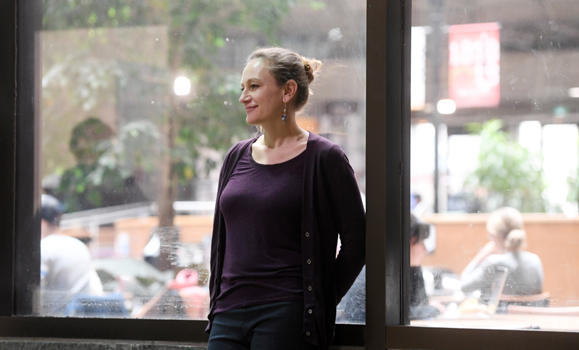As DalŌĆÖs student population has grown more diverse, so too have the universityŌĆÖs efforts to foster a more welcoming classroom environment for all.
Tereigh Ewert-Bauer joined DalŌĆÖs Centre for Learning and Teaching (CLT) in January as its first senior educational developer for diversity and inclusion, tasked with helping faculty better integrate inclusive perspectives and methods into curricula and pedagogy.
ŌĆ£The university is focusing on how the campus environment is enriched when diverse voices are heard,ŌĆØ says Ewert-Bauer, who spent 17 years working on inclusive pedagogies and Indigenization at the University of Saskatchewan before joining Dal.
Inclusion within learning environments
╠²
Ewert-BauerŌĆÖs role at CLT ranges from awareness-building and dispelling misconceptions, to promoting inclusive teaching strategies, assessment, inclusive curricula, programmatic outcomes, and intergroup relationships.
She endeavours to address issues of inclusion in the Dal community at every level and to collaborate with faculty as they continue to develop an awareness of their studentsŌĆÖ diversity and intersectionality.
ŌĆ£We are all made up of different aspects of identity ŌĆö gender, race, ability, nationality, religion, and so many more. We are never one thing at one time and itŌĆÖs important to address that in classes,ŌĆØ says Ewert-Bauer.
Brad Wuetherick, CLTŌĆÖs executive director, says advancing diversity and inclusivity in the teaching and learning environment is critical for Dal as it enters its third century.
ŌĆ£Whether in the curriculum we develop, the pedagogies we use, the assessments we design, or the environments we create in our classrooms, moving forward with diversity and inclusivity requires the engagement of every instructor on campus,ŌĆØ he says.
Wuetherick notes that Dal is among only a handful of institutions in Canada to create a dedicated position to support faculty in this area ŌĆö a testament to the commitment of the university in creating a more diverse and inclusive campus.
ŌĆ£This new position in CLT is an important signifier that ┬ķČ╣┤½├Į takes diversity and inclusivity very seriously, but collectively we have a lot of work to do to move forward,ŌĆØ he says.

Ewert-Bauer remembers speaking to an Indigenous student who felt that when they entered a classroom, they had to check their identity at the door. This raised the issue of belonging, a critical component of inclusion CLT hopes to address.
While creating a sense of belonging is not an easy task, Ewert-Bauer believes it can be done through capacity building and equitable representation in both teaching and learning.
ŌĆ£Our goals around inclusion require a paradigm shift. One of the most important things is capacity building, making sure diverse voices, experiences, knowledge and world views are equally represented in program and curriculum design as well as policies and proceduresŌĆØ she says.
A catered approach
╠²
CLTŌĆÖs strategy is to start working with people from ŌĆśwhere they are at.ŌĆÖ
ŌĆ£In some areas tremendous strides have been made, but in others it is just starting as people see that diversity and inclusion as relevant, regardless of the disciplineŌĆØ she says.
To that end, Ewert-Bauer has been integral to the development of the Building Belonging series of workshops taking place throughout 2018 as part of Dal 200ŌĆÖs broader Year of Belonging initiative.
The first session held Thursday centred on themes raised as part of the inaugural Belong Forum Wednesday night with MIT historian Craig Steven Wilder. Similar CLT-hosted sessions will be held after each forum.
Campus leaders, faculty and others, including Dr. Wilder, gathered Thursday to share their thoughts on racism and inequities in post-secondary institutions.
With diverse life experiences and identities herself, Ewert-Bauer empathizes with diverse peoples. She says she recognizes her privilege and feels a responsibility to do her part to create a better, more just environment for everyone.
ŌĆ£We have a long way to go, but engaging in this work will help move us towards an inclusive and equitable campus where everyone can achieve their potential.ŌĆØ

